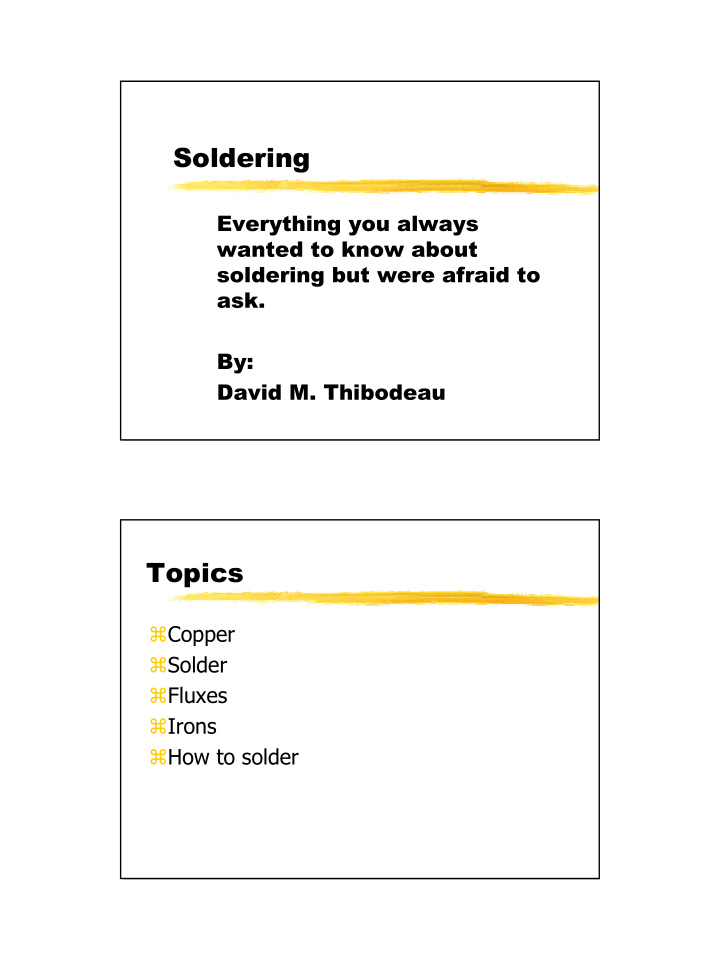



Soldering Everything you always wanted to know about soldering but were afraid to ask. By: David M. Thibodeau Topics � Copper � Solder � Fluxes � Irons � How to solder 1
Definition � A joining process wherein coalescence is produced by heating, generally below 800 deg. F, and by using a non-ferrous filler metal that has a melting point below that of the base metal. Good things about Copper � Good conductor of electricity � Plentiful and cheap � It has the ability to fuse into or alloy with solder, under certain controlled conditions. 2
Bad things about Copper � Heat tends to make it brittle � It oxidizes rapidly forming an invisible film similar to rust on iron. � The application of heat accelerates this oxidation. Solder � 60% Tin and 40% Lead. (60/40) � Sometimes 63/37 is used. � Becomes liquid at 360 degrees F. 3
Note: � Pure Lead melts at 621 deg. � Pure Tin melts at 450 deg. � 60/40 alloy melts at 360 deg. � Now you know the rest of the story! Definition: Tinning (wetting) � When molten solder leaves a continuous, permanent film on the metal surface. 4
Definition: Flux � Soldering flux is a liquid, solid or gaseous material which, when heated, is capable of promoting or accelerating the wetting of metals with solder. The Purpose of Flux � Is to remove and exclude oxides and other impurities from the joint being soldered. � Lowers the surface tension of molten solder so the solder will flow readily and adhere to the metal. � Flux is NOT a cleaning agent, it will just remove tarnishes and film and prevent re- oxidation when the copper is heated. 5
Note: � Soldering flux is often manufactured into the core of solder. � Acid Flux is used for plumbing, DO NOT USE!! � Use Rosin type of flux. Types of Soldering Irons � Electrode Tip Resistance � Self Contained heating element 6
Soldering Iron Tip Types � Copper � Copper Alloys � Impregnated copper (Alum. Diffusion) � Metal clad copper tips (Iron, nickel, etc.) Soldering Iron Tip Sizes and Shapes � There are various sizes and shapes available. The tip chosen will depend on the job at hand. 7
Care of your Soldering Iron � Keep soldering tip well tinned and clean � Clean it with a quick swipe on a wet sponge � Then tin the iron with fresh solder. � Always keep fresh solder on the iron when not in use. So How Do I Solder? � You simultaneously heat the junction of the two metals involved to a temperature hot enough to melt solder and fuse with the solder. 8
So how do I know when it is hot enough? � By having the Iron heat up the work ( the metals ) and then have the work heat up the solder until it melts. So what melts the solder? � THE WORK! 9
The other Secret? � To get good at soldering takes practice! Solder Joints � Should look clean and shiny! � You should see the outline of the component under the solder, use enough solder but not too much. � DO NOT leave any flux in the joint. � Do not move the joint before the solder cools � A cold solder joint has a gray mushy appearance. 10
Recommend
More recommend